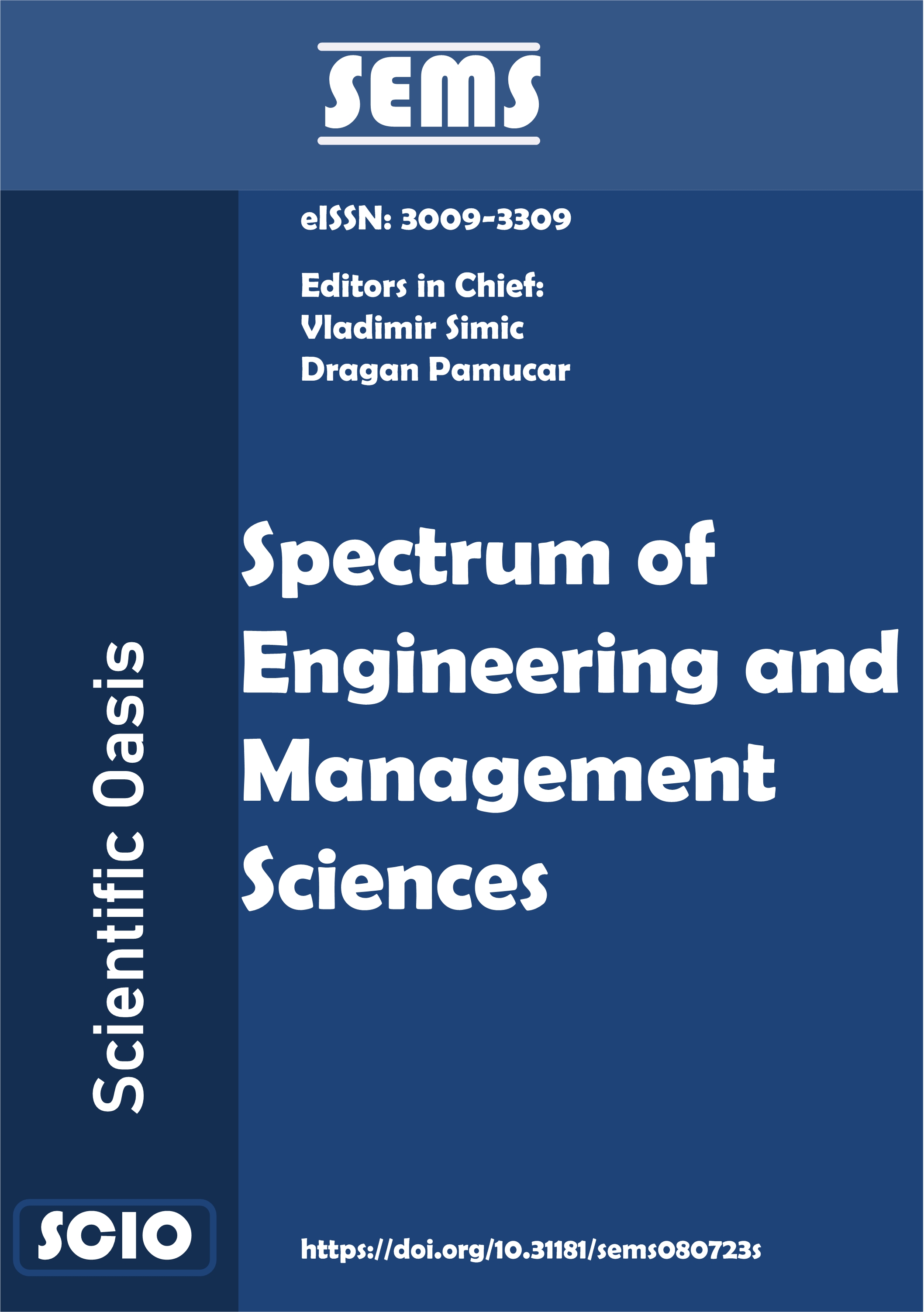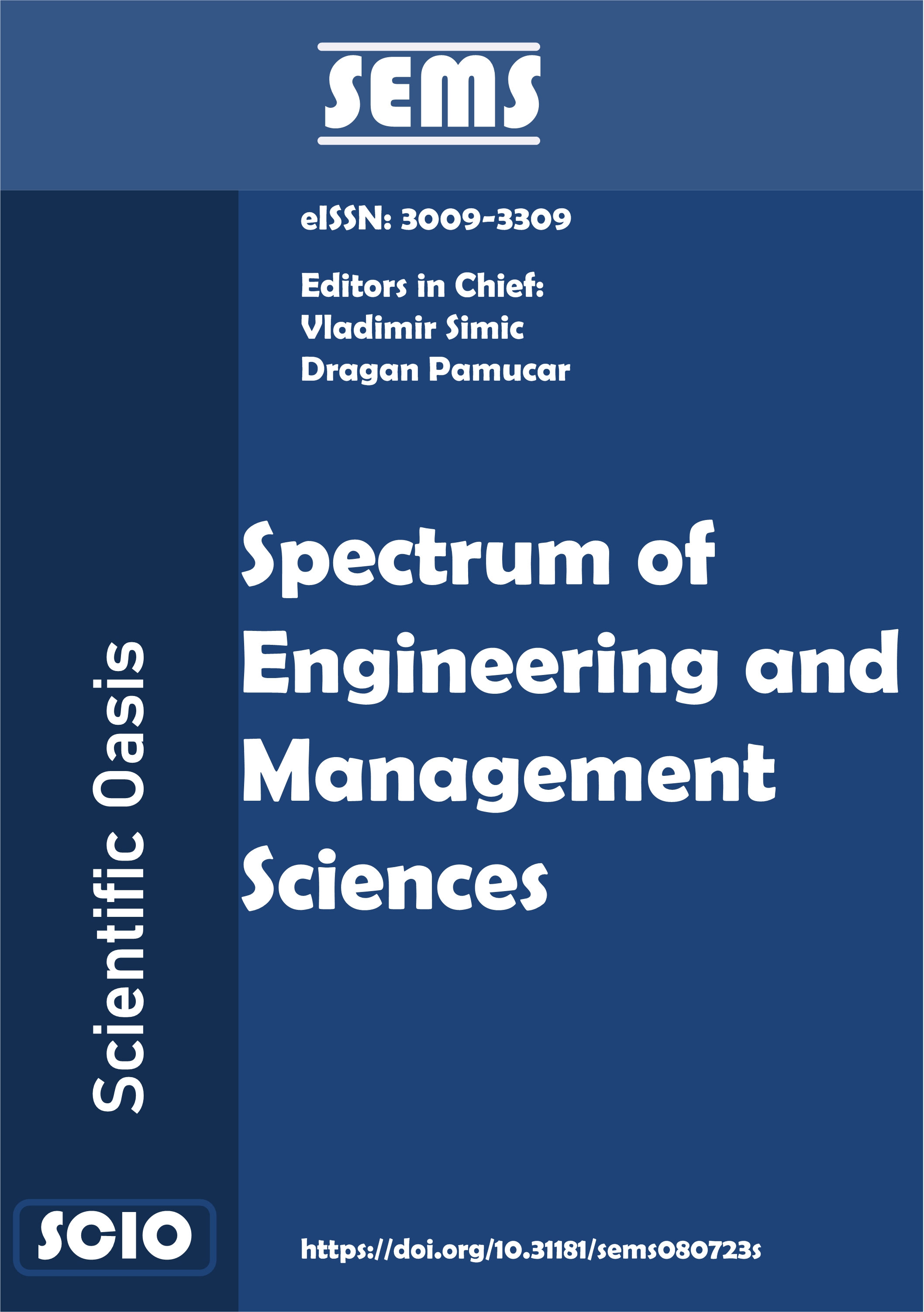Circular Intuitionistic Fuzzy EDAS Approach: A New Paradigm for Decision-Making in the Automotive Industry Sector
DOI:
https://doi.org/10.31181/sems31202537iKeywords:
Automotive Industry, Battery Recycling, CIF-EDAS Framework, Electric Vehicles (EVs), Sustainable Decision-MakingAbstract
The automotive industry has become a robust manufacturing sector in the global manufacturing field, boosting and developing at high speed based on technology updates, environmental protection rules and regulation changes, and customers' new needs and demands. Such dynamics give rise to complex problems like optimizing cost strategy and innovation, operating under high sustainability standards, and navigating the supply chain. These difficulties have led to the need for more structured, logical and effective approaches to decision-making that can handle cross purposes and the world of slow changes and unpredictability. To mitigate these problems, in this context, this study presents the Circular Intuitionistic Fuzzy EDAS (CIF-EDAS) approach to handle decision-making challenges in the automotive industry. Integrating the circular intuitionistic fuzzy sets (CIFSs) with the EDAS approach provides a better assessment of uncertainty and hesitation, enhancing the reliability and strength of multi-criteria decision-making (MCDM) methods. The applicability of the proposed approach is illustrated by a case study in the automotive industry, in which the assessment of different scenarios based on conflicting criteria is effective. Moreover, a comparison analysis has been conducted, demonstrating the proposed approach's superiority and highlighting its efficacy in facilitating robust decision-making. The CIF-EDAS approach is clarified to exemplify its applicability in optimizing decision-making of complicated real-life industrial problems and demonstrating its capability to evolve for the automotive industry's newly emergent restrictive and dynamic demand.
References
Alioğulları, E., Türkan, Y. S., Çakmak, E., & Tirkolaee, E. B. (2024). Evaluation of risk strategies for supply chain sustainability with interval-valued neutrosophic fuzzy EDAS. Heliyon, 10(19). https://doi.org/10.1016/j.heliyon.2024.e38607
Atanassov, K. T., & Atanassov, K. T. (1999). Intuitionistic fuzzy sets (pp. 1-137). Physica-Verlag HD. https://doi.org/10.1007/978-3-7908-1870-3_1
Atanassov, K. T. (2020a). Circular intuitionistic fuzzy sets. Journal of Intelligent & Fuzzy Systems, 39(5), 5981–5986. https://doi.org/10.3233/JIFS-189072
Atanassov, K. T. (2020b). Circular intuitionistic fuzzy sets. Journal of Intelligent & Fuzzy Systems, 39(5), 5981–5986. https://doi.org/10.3233/JIFS-189072
Bas, S. A. (2024). A Hybrid Approach Based on Consensus Decision Making for Green Supplier Selection in Automotive Industry. Sustainability, 16(7), 3096. https://doi.org/10.3390/su16073096
Beinabadi, H. Z., Baradaran, V., & Komijan, A. R. (2024). Sustainable supply chain decision-making in the automotive industry: A data-driven approach. Socio-Economic Planning Sciences, 95, 101908. https://doi.org/10.1016/j.seps.2024.101908
Bulut, M. S., Ordu, M., Der, O., & Basar, G. (2024). Sustainable Thermoplastic Material Selection for Hybrid Vehicle Battery Packs in the Automotive Industry: A Comparative Multi-Criteria Decision-Making Approach. Polymers, 16(19), 2768. https://doi.org/10.3390/polym16192768
Çakır, E., & Taş, M. A. (2023). Circular intuitionistic fuzzy decision making and its application. Expert Systems with Applications, 225, 120076. https://doi.org/10.1016/j.eswa.2023.120076
Chakhrit, A., Bougofa, M., Guetarni, I. H. M., Bouafia, A., Kharzi, R., Nehal, N., & Chennoufi, M. (2024). A hybrid integrated multi-criteria decision-making approach for risk assessment: A study of automotive parts industry. International Journal of Quality & Reliability Management, 41(4), 1020–1043. https://doi.org/10.1108/ijqrm-01-2023-0010
Dong, Q., & Yuan, Y. (2025). Data‐driven distributionally robust supplier selection and order allocation problems considering carbon emissions. International Transactions in Operational Research, 32(2), 1119–1145. https://doi.org/10.1111/itor.13328
Gao, M., Zhang, L., Qi, W., Cao, J., Cheng, J., Kao, Y., Wei, Y., & Yan, X. (2020). SMC for semi-Markov jump TS fuzzy systems with time delay. Applied Mathematics and Computation, 374, 125001. https://doi.org/10.1016/j.amc.2019.125001
Ge, J., & Zhang, S. (2020). Adaptive Inventory Control Based on Fuzzy Neural Network under Uncertain Environment. Complexity, 2020, 1–10. https://doi.org/10.1155/2020/6190936
Görçün, Ö. F., Mishra, A. R., Aytekin, A., Simic, V., & Korucuk, S. (2024). Evaluation of Industry 4.0 strategies for digital transformation in the automotive manufacturing industry using an integrated fuzzy decision-making model. Journal of Manufacturing Systems, 74, 922–948. https://doi.org/10.1016/j.jmsy.2024.05.005
Imran, R., Ullah, K., Ali, Z., & Akram, M. (2024a). A multi-criteria group decision-making approach for robot selection using interval-valued intuitionistic fuzzy information and Aczel-Alsina Bonferroni means. Spectrum of Decision Making and Applications, 1(1), 1–32. https://doi.org/10.31181/sdmap1120241
Imran, R., Ullah, K., Ali, Z., & Akram, M. (2024b). An approach to multi-attribute decision-making based on single-valued neutrosophic hesitant fuzzy aczel-alsina aggregation operator. Neutrosophic Systems with Applications, 22, 43–57. https://doi.org/10.61356/j.nswa.2024.22387
Imran, R., Ullah, K., Ali, Z., Akram, M., & Senapati, T. (2023). The theory of prioritized Muirhead mean operators under the presence of complex single-valued neutrosophic values. Decision Analytics Journal, 7, 100214. https://doi.org/10.1016/j.dajour.2023.100214
Jafar, M. N., Imran, R., Riffat, S. H. A., & Shuaib, R. (2020). Medical diagnosis using neutrosophic soft matrices and their compliments. Infinite Study.
Kara, K., Acar, A. Z., Polat, M., Önden, İ., & Yalçın, G. C. (2024). Developing a hybrid methodology for green-based supplier selection: Application in the automotive industry. Expert Systems with Applications, 249, 123668. https://doi.org/10.1016/j.eswa.2024.123668
Khalid, S. (2025). Advanced Electric Propulsion Systems for Hybrid Electric Vehicles: Design, Control, and Performance Optimization. In Hybrid Electric Vehicles and Distributed Renewable Energy Conversion: Control and Vibration Analysis (pp. 1–54). IGI Global Scientific Publishing. https://doi.org/10.4018/979-8-3693-5797-2.ch001
Koirala, K. & Shabbiruddin. (2023). Optimal selection of sustainable battery supplier for electric vehicle battery swapping station. Energy Sources, Part A: Recovery, Utilization, and Environmental Effects, 45(1), 2206–2227. https://doi.org/10.1080/15567036.2023.2185702
Kumar, R., & Sahoo, S. K. (2025). A Bibliometric Analysis of Agro-Based Industries: Trends and Challenges in Supply Chain Management. Decision Making Advances, 3(1), 200–215. https://doi.org/10.31181/dma31202568
Mahmood, T., Ullah, K., Khan, Q., & Jan, N. (2019). An approach toward decision-making and medical diagnosis problems using spherical fuzzy sets. Neural Computing and Applications, 31(11), 7041–7053. https://doi.org/10.1007/s00521-018-3521-2
Pratama, D., Yusoff, B., & Abdullah, L. (2024). Some operations on circular intuitionistic fuzzy sets. AIP Conference Proceedings, 2905(1). https://doi.org/10.1063/5.0171678
Saqlain, M., Imran, R., & Hassan, S. (2022). Cubic intuitionistic fuzzy soft set and its distance measures. Scientific Inquiry and Review, 6(2), 59–75. https://doi.org/10.32350/sir.62.04
Sarwar, M., & Li, T. (2019). Fuzzy fixed point results and applications to ordinary fuzzy differential equations in complex valued metric spaces. Hacettepe Journal of Mathematics and Statistics, 48(6), 1712–1728. https://doi.org/10.15672/HJMS.2018.633
Saulaiman, M. N.-E., Csilling, A., & Kozlovszky, M. (2025). Integrated Automation for Threat Analysis and Risk Assessment in Automotive Cybersecurity Through Attack Graphs. Acta Polytechnica Hungarica, 22(2). https://doi.org/10.12700/APH.22.2.2025.2.8
Saravanan, V., Ramachandran, M., Selvam, M., & Raja, C. (2023). Application of the EDAS Technique for Selecting the Electric Motor Vehicles. Journal on Electronic and Automation Engineering, 2(4), 27-36. https://doi.org/10.46632/jeae/2/4/4
Singh, R. R., Zindani, D., & Maity, S. R. (2024). A novel fuzzy-prospect theory approach for the automotive industry's hydrogen fuel cell component supplier selection. Expert Systems with Applications, 246, 123142. https://doi.org/10.1016/j.eswa.2024.123142
Sun, Q., Ren, J., & Zhao, F. (2022). Sliding mode control of discrete-time interval type-2 fuzzy Markov jump systems with the preview target signal. Applied Mathematics and Computation, 435, 127479. https://doi.org/10.1016/j.amc.2022.127479
Xia, Y., Wang, J., Meng, B., & Chen, X. (2020). Further results on fuzzy sampled-data stabilization of chaotic nonlinear systems. Applied Mathematics and Computation, 379, 125225. https://doi.org/10.1016/j.amc.2020.125225
Yager, R. R. (2013, June). Pythagorean fuzzy subsets. In 2013 joint IFSA world congress and NAFIPS annual meeting (IFSA/NAFIPS) (pp. 57-61). IEEE. https://doi.org/10.1109/IFSA-NAFIPS.2013.6608375
Yager, R. R. (2016). Generalized orthopair fuzzy sets. IEEE transactions on fuzzy systems, 25(5), 1222-1230. https://doi.org/10.1109/TFUZZ.2016.2604005
Zadeh, L. A. (1988). Fuzzy logic. Computer, 21(4), 83-93.. https://doi.org/10.1109/2.53
Zhang, N., Qi, W., Pang, G., Cheng, J., & Shi, K. (2022). Observer-based sliding mode control for fuzzy stochastic switching systems with deception attacks. Applied Mathematics and Computation, 427, 127153. https://doi.org/10.1016/j.amc.2022.127153
Downloads
Published
Issue
Section
License
Copyright (c) 2025 Scientific Oasis

This work is licensed under a Creative Commons Attribution-NonCommercial-NoDerivatives 4.0 International License.













